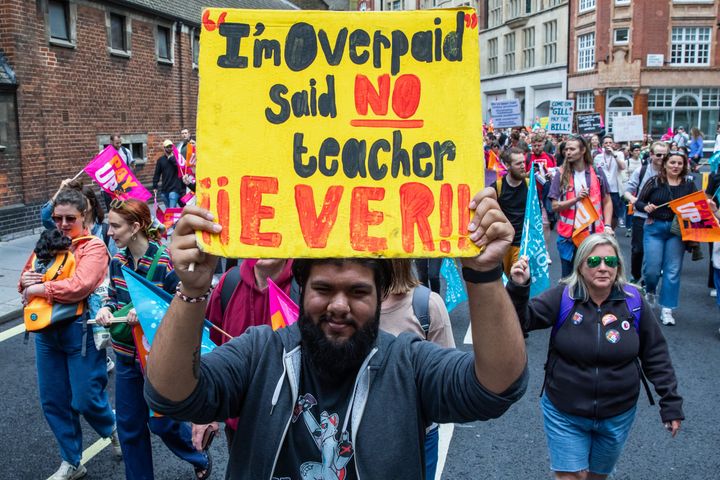
As members of teaching unions prepare to strike for the second time this week on Friday, it’s worth remembering why so many feel they have no choice but to walk out.
Many schools in England had to close on Wednesday as an estimated 300,000 teachers up and down the nation went on strike for the sixth day since February.
Organised by the National Education Union (NEU), the industrial action is an attempt by teachers are putting pressure on the government to increase their pay.
They have already received a 5% pay rise for the year 2022-23, but inflation at the moment is at 8.7% and union members want their pay to reflect that.
They are also asking for additional budget to make sure any pay rises don’t come at the detriment to the current school budget.
While the Department for Education claims school funding will soon be taken to “its highest level in history next year”.
It also noted that it is currently appraising the independent School Teachers’ Review Body’s recommendations for teacher pay for 2023/24.
But, there have been no recent negotiations between the unions and the Department for Education. Unions already rejected the government’s one-off payment of £1,000 and a 4.3% pay rise for most teachers next year in March.
All four unions also announced on Wednesday that they could launch the biggest strike in a decade from September as part of a “united front”.
Here’s seven facts about working in education you might not be aware of.
1. Teachers don’t get paid for strike days
Although the strike is about teachers’ pay – and strikers’ calls for it to be increased – those who walk out don’t get paid on strike days.
2. There are more classes with more than 30 pupils in them than ever before
That means more than a million pupils are in these very large classes, according to 2021 analysis from Labour.
It claimed that this figure (of classes with 30+ students in) has increased from impacting one in 10 secondary school students in 2010 to almost one in seven in 2021.
The BBC reported this week that one Gloucester teacher had 64 pupils in just one class, and he was therefore unable to give them “a really good education”.
The Department for Education claims the average size is 22.4 pupils.
There are restrictions on class sizes for those aged 5-7 needing to be in a class of 30 or fewer, but there’s no such similar rule for children in Key Stage 2 and above.
Research from the teaching union NASUWT from 2022 also found 75% of teachers said class sizes were getting bigger, due to teacher shortages and higher numbers of children being registered.
3. Teachers use own money to feed hungry children
A September 2022 study which polled 6,500 teachers found 58% use their own money to provide food and clothing to pupils in need.
The statistics from NASUWT also found a further 15% of teachers offered cash to children who were struggling to eat.
4. Per pupil spending is likely to fall
The Institute for Fiscal Studies predicted that spending per pupil in 2024-2-25 is expected to be 3% less than it was in 2010, following more than a decade of austerity – with the more deprived areas most affected.
5. Teachers to see real-terms pay cut
The Institute for Fiscal Studies found that in real terms, pay will probably fall by 5% in real terms for teachers this school year (2023) for those just starting out.
Teachers in the middle of the salary scale have already had a cut of 9-10% since 2010.
Experienced and senior teachers have seen a real-terms pay cut by 13% since 2010.
6. Almost half of teachers plan to be out by 2027
Last April, as many as one in three teachers were thinking about quitting in the next five years, according to research from the NEU.
A more recent survey conducted this year found 44% plan to leave the profession by 2027.
7. Teachers work more unpaid overtime than anyone else
According to Trades Union Congress research from 2019, most UK teachers work more than a day of unpaid overtime every week – that was the most of any sector surveyed.
That also amounts to nine million hours of free labour a week, 462 million hours a year, and an average of 12.1 hours unpaid for each individual every week.
Primary school teachers were found to do the most unpaid overtime with 13 hours extra per week, with secondary school teachers a close second at 12.8 hours, while pre-school teachers were on 6.4 hours.
By 2022, TUC found only chief executives beat these stats on average, as they work 12.5 extra unpaid hours a week, compared to teachers and educational professionals whose extra hours had dropped to (a still very high) 11.9 hours of unpaid weekly labour.
